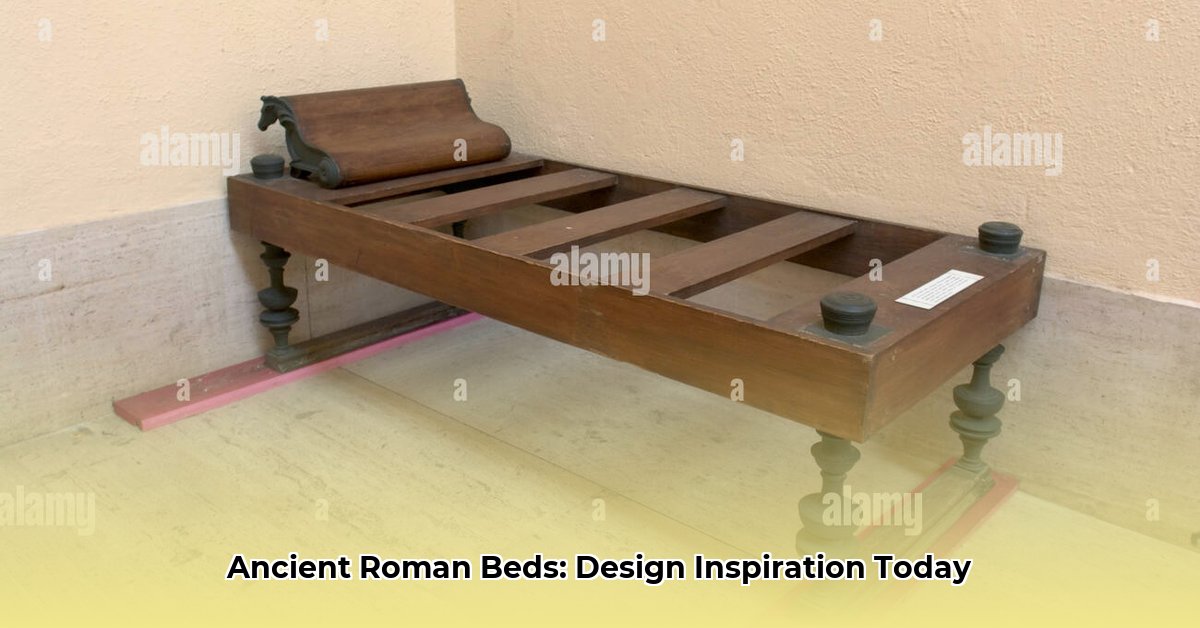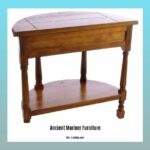Ever wondered what it truly meant to rest in ancient Rome? Discard any notions of a modern spring mattress for a moment and instead, visualize the Roman bed, or lectus. Far more than a mere surface for sleep, it served as a profound status symbol, a convivial dining couch, and even a solemn stage for important ceremonies. This exploration pulls back the dusty curtains on these remarkable pieces of furniture, revealing their intricate history. We uncover the distinct types of lecti utilized—from comfortable nocturnal sanctuaries to the elaborate couches upon which Romans reclined while feasting. We’ll also examine the materials and meticulous craftsmanship involved, alongside how these beds were deeply interwoven with Roman societal structures. Prepare to unlock the secrets of the lectus and discover how this ancient furniture subtly continues to inspire contemporary designs.
The Lectus: A Multifaceted Centerpiece of Roman Life
The rich tapestry of ancient Roman life, characterized by its intricate social structures and impressive displays of wealth, offers a unique window into the past. Among the many facets of their daily existence, the ancient Roman bed stands out, quietly narrating tales of both personal intimacy and grand public spectacle. Learn more about the Roman bedroom and its furnishings. What insights do these fascinating furnishings provide about the mechanics of Roman society, and how might they subtly continue to shape today’s design sensibilities, even within your own home?
The Romans were pragmatists, employing different types of lecti for various purposes, a practice that directly reflected their societal values regarding utility, comfort, and social display. This functional diversity is a key takeaway from archaeological findings and historical texts.
Principal Types of Roman Beds and Their Purpose
The lectus was not a singular item but a diverse category, each type meticulously designed for a specific function within the Roman household. This functional diversity underscores the Romans’ pragmatic approach to furniture.
- Lectus Cubicularis: This was the primary sleeping bed, typically found within the cubiculum (the Roman bedroom). While primarily for night rest, it could also serve as a setting for private conversations or quiet introspection during the day. Historical records and visual representations indicate these beds often featured a raised wooden platform, sometimes embellished with elegant bronze accents, and were layered with cushions and blankets for supreme comfort. For the wealthy, these were lavish affairs, while the average Roman citizen might use a simpler, low-lying latiboia made of straw or reeds. Archaeological findings, such as the slave beds uncovered in Civita Giuliana, a suburb of Pompeii, reveal humble versions made of wooden posts strung with thin rope and covered with loose blankets, sometimes even harboring rodent remains beneath.
- Lectus Triclinaris: More than just a bed, this was a specialized reclining couch crucial for Roman dining. Romans famously reclined on these while eating, a practice that vividly underscored their social status and prosperity. Can you imagine hosting a dinner party today where guests are casually lounging on couches instead of sitting at a table? This custom starkly contrasts with modern Western dining traditions, highlighting the distinct social rituals of the era. The lectus triclinaris was generally larger and more elaborately decorated than a sleeping bed, often featuring artistic depictions of mythological scenes or symbols of abundance, befitting the celebratory atmosphere of a Roman banquet. These massive couches often sat three people, with special armrests to support plates.
- Lectus Nuptialis: This specific type of bed, often adorned with symbols of fertility and mythical gods, was central to Roman wedding ceremonies. It represented the union of two families and was where the bride and groom would be seated. Often, these marriage beds were symbolically linked to fertility, with beliefs that certain plants or images could grant children to a couple.
- Lectus Funerarius: Exclusively used for funeral rites, this bed served as a dignified display for the deceased during mourning ceremonies, emphasizing the profound importance of honoring ancestors and the recently departed within Roman culture. These solemn beds were typically draped in dark, respectful fabrics and adorned with flowers, providing a dignified setting for final farewells. A rare and significant discovery in London unearthed a complete Roman funerary bed crafted from oak, intended as a grave good for use in the afterlife.
This multi-functionality confirms that Roman beds, or lecti, held immense significance, serving as more than just sleeping spaces, a pivotal point when comparing them to modern furniture.
Crafting Opulence and Comfort: Materials and Artisanship in Roman Beds
Unlike the mass-produced furniture of our modern era, ancient Roman beds were often bespoke creations, emphasizing quality over quantity. The materials selected for their construction offer fascinating insights into Roman engineering, economic networks, and aesthetic preferences. But what went into the creation of these functional works of art, and how did trade influence furniture design and availability across the Empire?
Diverse Material Selection and Their Crafting
The choice of materials for Roman beds was a direct reflection of an individual’s wealth, status, and sometimes, regional availability. The perishable nature of wood means that most insights come from indirect sources like historical texts, wall paintings, and metal fittings, though some complete pieces made of stone or metal have survived.
- Wood: Common, locally sourced woods such as oak, maple, beech, elm, and sycamore were frequently utilized for the structural framework. However, the opulent elite would import exotic varieties like highly prized citrus wood (renowned for its beauty and fragrance), cedar from Lebanon, or even ebony from Kush, transforming a simple piece of furniture into a declaration of affluence. The wood trade was critical, with pharaohs even controlling tree cutting and having personal trading fleets. The very selection of wood could subtly convey social standing to an astute observer. For instance, citrus wood tables could cost exorbitant sums, with Cicero reportedly paying $20,000 for one.
- Bronze and Metals: Beyond its functional role in reinforcing joints and providing support, bronze was extensively used for decorative elements and ornate fittings. Its durability and resistance to corrosion made it ideal for intricate designs and personalized embellishments, showcasing the owner’s refined taste. Gold and silver inlays were reserved for the most lavish pieces, showcasing extreme wealth. Bronze was adopted significantly in the Middle Kingdom and revolutionized furniture-making, allowing for easier creation of armrests, backrests, and side-panels. Iron, introduced by the Hyksos, was even more suited for furniture creation.
- Upholstery and Bedding: Comfort was a high priority for those who could afford it. On a wooden frame reinforced with interwoven straps or thongs that acted as springs, a mattress (torus) and a bolster (culcita, cervical) were placed. Mattress stuffing (tomentum) varied significantly: the poor used straw or reeds, while the rich enjoyed wool (from prized Leuconian flocks) or even luxurious swan’s down. A mattress padded with leaves, possibly for antiparasitic action, was even found in Herculaneum. These mattresses were covered with two layers (tapetia): one (stragulum) for lying on, and another (operimentum) for covering. A counterpane (lodix) or multicolored damask quilt (polymitum) completed the ensemble. Wealthy Romans also adorned their beds with tapestries and vibrant, often embroidered, fabrics.
- Exotic Inlays: To further enhance luxury, materials like ivory, tortoise-shell, alabaster, faience, and even glass paste were used for intricate inlays on bed frames and legs. Animal legs carved from wood, bronze, or ivory, often in the shape of lions’ paws, ox hooves, or bird legs, were common decorative motifs, particularly for higher-status beds.
The Art of Roman Craftsmanship and Trade Networks
The construction of these beds was a testament to the skill of Roman artisans. Highly skilled craftspeople meticulously crafted each piece, demonstrating a profound value for quality and an acute attention to fine details. This precise joinery and careful artistry often meant beds were made to last, mirroring the Roman commitment to longevity in their architecture and infrastructure. Carpenters used advanced tools like pull-saws (introduced in the First Dynasty with uncanted teeth for greater accuracy and ease of movement), adzes for shaping, and specialized sharpening instruments.
Trade routes were crucial for acquiring the exotic and precious materials that defined luxury Roman furniture. Cities like Byblos and later Ugarit, Sidon, and Tyre in the Levant were vital trade outposts, exporting valuable woods like cedar, fir, pine, yew, and cypress to Egypt and other parts of the Roman world. Other materials like lapis lazuli, tin, copper, gold, silver, turquoise, and malachite were also traded extensively, used not only for furniture decoration but as diplomatic gifts between pharaohs and other nations. This extensive network allowed Roman elites to commission truly unique and lavish pieces.
Beyond Comfort: Social Statements in Roman Bed Design
The ancient Roman bed provided a wealth of information about Roman society, clearly transcending its basic function. It was not merely a place for repose or sustenance; it was a powerful social statement. Would you consider that a bed could so overtly define one’s place in society today?
The Bed as a Status Symbol
An elaborately decorated lectus unequivocally communicated wealth and power. The materials used, ranging from humble wicker or terracotta for the poor to exotic woods, ivory, bronze, silver, and gold accents for the elite, along with the quality of the craftsmanship, conveyed significant information about the owner’s social standing. The sheer size and extravagance of the bed directly correlated with one’s social standing. Wealthy Romans often commissioned beds adorned with precious metals and intricate carvings, serving as a blatant display of affluence and access to extensive trade networks. This highlights a second pivotal point: material choices for beds vividly reflected a person’s wealth and status in Roman society.
Privacy and Public Function
While bedrooms (cubicula) existed, the concept of privacy in ancient Rome differed significantly from modern notions. The lectus cubicularis could serve as a site for intimate moments, yet it was also a place where business meetings might be conducted or guests received, blurring the lines between private and semi-public spaces within the Roman domus. For instance, wealthy Romans would often use their beds as luxurious couches to meet with visitors, even receiving them while still reclining. This suggests a more fluid boundary between personal and social spheres.
Dining and Social Hierarchy
The lectus triclinaris was central to Roman social gatherings, especially banquets. The custom of reclining while dining was a profound reinforcement of social hierarchy, with specific seating positions assigned to guests based on their status and importance, thus emphasizing the host’s authority. This practice was deeply embedded in their cultural norms and offered a fascinating contrast to the more formal, seated dining prevalent in many cultures today. Even the quantity of beds could signify wealth, with some opulent dining rooms featuring couches for six or more people.
Timeless Echoes: Roman Beds and Their Modern Design Legacy
Can the ingenuity of these ancient designs truly inform our contemporary aesthetics? Absolutely. Think about the enduring principles that made Roman furniture both functional and elegant. The enduring appeal of Roman design lies in its seamless blend of utility and beauty. Many experts believe that the Romans’ exceptional ability to create furniture that served both practical and symbolic purposes continues to resonate profoundly with modern consumers who seek meaningful, well-crafted pieces. This serves as our third pivotal point: the design and materials of these beds continue to influence modern furniture trends.
| Feature | Ancient Roman Bed (Historical Context) | Modern Interpretation (Contemporary Design) |
|---|---|---|
| Materials | Locally sourced woods (beech, elm), imported exotic woods (citrus, cedar, ebony), bronze, linen, wool, ivory, tortoise-shell, gold, silver. | Sustainably sourced hardwoods (oak, walnut), metal accents (brass, steel), natural fiber upholstery (linen, wool), recycled materials, eco-friendly finishes. |
| Design Elements | Geometric patterns, animal motifs (lion paws, ox hooves), classical forms (columns, arches), clean lines, intricate inlays, rich ornamentation. | Minimalist forms, textured fabrics, sleek metal frames, inspired classical motifs (geometric patterns, subtle curves), integrated lighting, smart home features. |
| Functionality | Sleeping, dining, business meetings, ceremonial display, socializing, fertility symbolism. | Multi-functional furniture (sofa beds, storage beds), adaptable living spaces (modular sections), integrated storage solutions, flexible configurations for various activities. |
| Overall Aesthetic | Opulent, luxurious, symbolic, durable, meticulously crafted, reflecting social status. | Elegant, comfortable, timeless, sustainable, high-quality, personalized, emphasizing craftsmanship and longevity. |
How to Recreate the Luxurious Ancient Roman Bed in a contemporary setting isn’t about direct replication, but rather about channeling the core design philosophies. Interior designers and furniture makers can capture the essence of Roman aesthetics through a few key principles, fostering a classic and enduring quality:
- Embrace Minimalism and Clean Lines: Focus on uncluttered forms and elegant restraint over excessive ornamentation. This mirrors the Roman preference for sophisticated simplicity in their structural elements, creating a serene and timeless atmosphere that enhances spatial harmony.
- Utilize Sustainable and Quality Materials: Opt for locally sourced hardwoods and high-quality, natural fibers. This echoes the Romans’ resourceful use of available materials and their emphasis on durability and longevity. Consider reclaimed woods or innovative eco-friendly textiles to connect with ancient resourcefulness while embracing modern sustainability.
- Incorporate Subtle Classical Design Elements: Integrate discreet mosaic patterns, bronze or metal accents, and classical motifs in a contemporary way. These elements can evoke a sense of history and grandeur without overwhelming the space. Think of fluted details on bed legs, a subtle key pattern border on upholstery, or a statement headboard that echoes grand Roman architecture.
- Prioritize Craftsmanship and Durability: Emphasize meticulous attention to detail and robust construction. Just as Roman artisans took pride in creating pieces designed to last centuries, modern design should prioritize durability and fine finishing. Investing in well-made furniture ensures longevity and a connection to historical ideals of quality.
So, the next time you consider a furniture purchase, allow the rich history of the ancient Roman bed to guide your choices. Their designs, both functional and exquisitely elegant, are a testament to the Romans’ profound appreciation for detail and lasting quality. Incorporating a few design choices inspired by this ancient legacy could infuse a captivating touch of the Classical World into your own living space. Wouldn’t that be a truly special transformation?
















